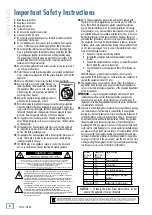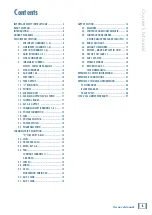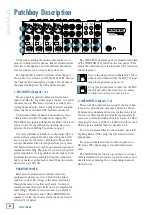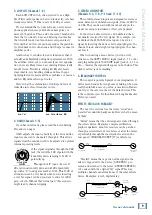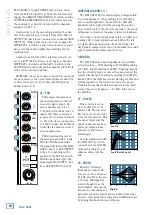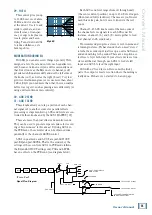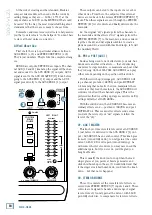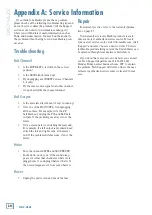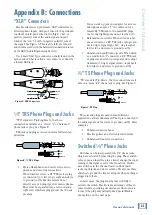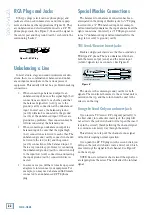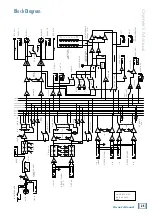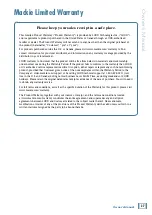
1
Owner’s Manual
Owner’
s Manual
29. HI EQ
This control gives you up
to 15 dB boost or cut above
12 kHz, and it is also flat
at the detent. Use it to add
sizzle to cymbals, and an
overall sense of transpar-
ency, or edge to keyboards,
vocals, guitar and bacon
frying. Turn it down a little
to reduce sibilance, or to
hide tape hiss.
MODERATION DURING EQ
With EQ, you can also screw things up royally. We’ve
designed a lot of boost and cut into each equalizer cir-
cuit, because we know everyone will occasionally need
that. But if you max the EQs on every channel, you’ll
get mix mush. Equalize subtly and use the left sides of
the knobs (cut), as well as the right (boost). Very few
gold-record-album engineers ever use more than about
3 dB of EQ. If you need more than that, there’s usually a
better way to get it, such as placing a mic differently (or
using a different kind of mic entirely).
30. AUX 2 SEND
31. AUX 1 SEND
These knobs allow you to tap a portion of each chan-
nel signal out to another source for parallel effects
processing or stage monitoring. AUX send levels are con-
trolled by these knobs and by the AUX 1 MASTER [39].
These are more than just effects and monitor sends.
They can be used to generate separate mixes for record-
ing or “mix-minuses” for broadcast. By using AUX 1 in
the PRE mode, these mix levels can be obtained inde-
pendently of the channel’s LEVEL control.
AUX 1 in post mode and AUX 2 are post-LOW CUT,
post-EQ and post-LEVEL. That is, the sends obey the
settings of these controls. AUX 1 in PRE mode follows
the EQ and LOW CUT settings only. PAN and LEVEL
have no effect on the PRE send (see diagram below).
20
Hz
100
Hz
1k
Hz
10k
Hz
20k
Hz
–15
–10
–5
0
+5
+10
+15
High EQ
Each AUX send level ranges from off through unity
(the center detent position) on up to 15 dB of extra gain
(when turned fully clockwise). Chances are you’ll never
need this extra gain, but it’s nice to know it’s there if
you do.
Channel 5–12 AUX knobs control the mono sum of
the channel’s stereo signals for each AUX send. For
instance, channel 5 (L) and 6 (R) mix together to feed
that channel’s AUX send knobs.
We recommend going into a stereo reverb in mono and
returning in stereo. We have found that on most “stereo”
reverbs the second input just ties up an extra AUX send
and adds nothing to the sound. There are exceptions, so
feel free to try it both ways. If your effects device is true
stereo all the way through, use AUX 1 to feed its left
input and AUX 2 to feed the right input.
Still with us? Good for you. Here come the tricky
parts, the output or master section where the mixing is
really done. We have even started it on a new page:
GAIN
INSERT
LO CUT
EQ
LEVEL
PAN
MAIN / ALT
AUX 2 KNOB
"POST" SIGNAL
"PRE" SIGNAL
AUX 1 KNOB
"POST" SIGNAL OBEYS
MUTE STATUS
INPUT
AUX SEND 1 PRE/POST SWITCH
(IN MASTER SECTION)
TO AUX SEND 2 LEVEL
TO AUX SEND 1 LEVEL
“Pre vs. Post”
Signal Flow Diagram


